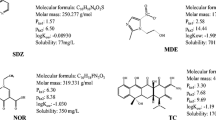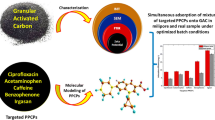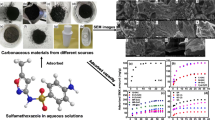Abstract
The equilibrium and intraparticle diffusion of ronidazole (RNZ) and sulfamethoxazole (SMX) during the adsorption on granular activated carbon (GAC) from aqueous solution was investigated in this work. The solution pH, temperature, ionic strength and water matrix affected the adsorption capacity of GAC towards SMX, but no effect was observed for the adsorption of RNZ. This behavior was due to the different mechanism involved in the adsorption of both antibiotics. The adsorption capacity of GAC towards RNZ was greater than that towards SMX. Molecular computation allowed the estimation of the binding free energy and confirmed that the adsorption of RNZ was more favorable than the adsorption of SMX. The adsorption mechanism of both antibiotics is governed by π–π dispersive interactions, and molecular simulation demonstrated that the coulombic interactions did not affect, but the solvation and nonpolar interactions play a significant role on the adsorption of both antibiotics. The application of diffusional models revealed that the overall adsorption rate of both antibiotics is controlled by intraparticle diffusion. Moreover, the surface diffusion was more predominant than the pore volume diffusion. Besides, surface diffusion coefficient, Ds, for RNZ was not a function of the aqueous matrix, whereas Ds for SMX was highly dependent on the water matrix.








Similar content being viewed by others
Notes
Chemical Computing Group, Montreal, Canada, http://www.chemcomp.com.s
Abbreviations
- a:
-
Radke–Prausnitz isotherm constant (L g−1)
- Ap :
-
Projected area of an antibiotic molecule (m2 molecule−1)
- b:
-
Radke–Prausnitz isotherm constant (mmol−β Lβ)
- Ce :
-
Concentration of antibiotic at equilibrium (mmol L−1)
- C A :
-
Concentration of antibiotic in aqueous solution (mg L−1)
- C A,pred :
-
Predicted concentration of antibiotic in aqueous solution (mg L−1)
- C A0 :
-
Initial concentration of antibiotic in aqueous solution (mg L−1)
- C Ar :
-
Concentration of antibiotic within the particle at distance r (mg L−1)
- C Ar|r=R :
-
Concentration of antibiotic at the external surface of the GAC particle at r = Rp (mg L−1)
- dp :
-
Average pore diameter (nm)
- D AB :
-
Molecular diffusion coefficient at infinite dilution (cm2 s−1)
- D ep :
-
Effective pore volume diffusion coefficient (cm2 s−1)
- D s :
-
Surface diffusion coefficient (cm2 s−1)
- K:
-
Constant of the Langmuir isotherm related to adsorption enthalpy (L mmol−1)
- k L :
-
External mass transfer coefficient in liquid phase (cm s−1)
- L0 :
-
Average width of the micropores
- m :
-
Mass of adsorbent (g)
- N:
-
Number of experimental data
- NA :
-
Avogadro’s number, 6.022 × 1023 (molecules mol−1)
- N AP :
-
Mass transport due to pore volume diffusion, mg cm−2 s−1
- N AS :
-
Mass transport due to surface diffusion, mg cm−2 s−1
- \( N_{\text{AS,r}} \) :
-
Radial average contribution of superficial contribution
- pKow :
-
Octanol–water partition coefficient
- pKa:
-
Acid dissociation constant
- pHPZC :
-
pH of Point Zero Charge
- q :
-
Uptake of antibiotic adsorbed (mmol g−1)
- qpred :
-
Uptake of antibiotic adsorbed predicted with the isotherm model (mmol g−1)
- qm :
-
Maximum adsorption capacity of GAC towards an antibiotic (mmol g−1)
- r :
-
Radial distance (cm)
- Rp :
-
Radius of the particle (cm)
- R :
-
Universal gas law constant, 8.314 (J mol−1 K−1)
- S:
-
External surface area per mass of adsorbent (cm2 g−1)
- SBET :
-
Surface area (m2 g−1)
- T:
-
Temperature (K)
- V:
-
Volume of the solution in adsorber (mL)
- VP :
-
Total pore volume (cm3 g−1)
- Vmic :
-
Micropore volume (cm3 g−1)
- β:
-
Radke–Prausnitz isotherm constant
- ɛ p :
-
Void fraction of GAC particles
- ρp :
-
Density of adsorbent particles (g mL−1)
- τ:
-
Tortuosity factor
- ΔHads :
-
Heat of adsorption (J mol−1)
- % D:
-
Average percentage of deviation
- % SOc :
-
Percentage of surface area occupied by antibiotic molecule adsorbed
References
Acar, J., Röstel, B.: Antimicrobial resistance: an overview. Rev. Sci. Eech. Off. Int. Epiz. 20, 797–810 (2001)
Baker, N.A., Sept, D., Joseph, S., Holst, M.J., McCammon, J.A.: Electrostatics of nanosystems: application to microtubules and the ribosome. Proc. Natl. Acad. Sci. 98, 10037–10041 (2001)
Boehm, H.P.: Chemical identification of surface groups. Adv. Cat. 16, 179–274 (1966)
Brown, K.D., Kulis, J., Thomson, B., Chapman, T.H., Mawhinney, D.B.: Occurrence of antibiotics in hospital, residential, and dairy effluent, municipal wastewater, and the Rio Grande in New Mexico. Sci. Total Environ. 366, 772–783 (2006)
Çaliskan, E., Göktürk, S.: Adsorption characteristics of sulfamethoxazole and metronidazole on activated carbon. Sep. Sci. Technol. 45, 244–255 (2010)
Calisto, V., Ferreira, C.I.A., Oliveira, J.A.B.O., Otero, M., Esteves, V.I.: Adsorptive removal of pharmaceuticals from water by commercial and waste-based carbons. J. Environ. Manage. 152, 83–90 (2015)
Coughlin, R.W., Ezra, F.S.: Role of surface acidity in the adsorption of organic pollutants on the surface of carbon. Environ. Sci. Technol. 2, 291–297 (1968)
Díaz-Cruz, M.S., García-Galán, M.J., Barceló, D.: Highly sensitive simultaneous determination of sulfonamide antibiotics and one metabolite in environmental waters by liquid chromatography-quadrupole linear ion trap-mass spectrometry. J. Chromatogr. A 1193, 50–59 (2008)
Do, D.D.: Adsorption Analysis: Equilibria and Kinetics, 1st edn. Imperial College Press, London (1998)
Friedman, R.A., Honig, B.: A free energy analysis of nucleic acid base stacking in aqueous solution. Biophys. J. 69, 1528–1535 (1995)
Froment, G.F., Bischoff, K.B.: Chemical Reactor Analysis and Design, 2nd edn. Wiley, Singapore (1990)
Furusawa, T., Smith, J.M.: Fluid-particle and intraparticle mass transport rates in slurries. Ind. Eng. Chem. Fundam. 12, 197–203 (1973)
Greenberg, A.E., Clesceri, L.S., Eaton, A.D.: Standard Methods for Examination of Water and Wastewater. Am. Public Health Assoc, Washington, DC (1992)
Hernández-Mesa, M.: Desarrollo de un método MEKC para la determinación de 5-Nitroimidazoles en aguas de río. Tesis de Maestría, Universidad de Granada, España (2011)
Hirsch, R., Ternes, T.A., Haberer, K., Mehlich, A., Ballwanz, F., Kratz, K.: Determination of antibiotics in different water compartments via liquid chromatography-electrospray tandem mass spectrometry. J. Chromatogr. A 815, 213–223 (1998)
Homem, V., Santos, L.: Degradation and removal methods of antibiotics from aqueous matrices—a review. J. Environ. Manage. 92, 2304–2347 (2011)
Howard, P.H., Meylan, W.H.: Handbook of Physical Properties of Organic Chemical. Lewis Publishers/CRC Press, Boca Raton (1997). 2112
Humphrey, W., Dalke, A., Schulten, K.: VMD—visual molecular dynamics. J. Mol. Graph. 14, 33–38 (1996)
Ji, L., Chen, W., Zheng, S., Xu, Z., Zhu, D.: Adsorption of sulfonamide antibiotics to multiwalled carbon nanotubes. Langmuir 25, 11608–11613 (2009)
Kümmerer, K.: Antibiotics in the aquatic environment—a review—Part I. Chemosphere 75, 417–434 (2009)
Lanz, R., Kuhnert, P., Boerlin, P.: Antimicrobial resistance and resistance gene determinants in clinical Escherichia coli from different animal species in Switzerland. Vet. Microbiol. 91, 73–84 (2003)
Leyva-Ramos, R., Geankoplis, C.J.: Diffusion in liquid-filled pores of activated carbon. I. Pore volume diffusion. Can. J. Chem. Eng. 72, 262–271 (1994)
Leyva-Ramos, R., Berber-Mendoza, M.S., Salazar-Rabago, J., Guerrero-Coronado, R.M., Mendoza-Barron, J.: Adsorption of lead(II) from aqueous solution onto several types of activated carbon fibers. Adsorption 17, 515–526 (2011)
Lian, F., Sun, B., Song, Z., Zhu, L., Qi, X., Xing, B.: Physicochemical properties of herb-residue biochar and its sorption to ionizable antibiotic sulfamethoxazole. Chem. Eng. J. 248, 128–134 (2014)
Lira-De León, K.I., García-Gutiérrez, P., Serratos, I.N., Palomera-Cárdenas, M., Figueroa-Corona, M.P., Campos-Peña, V., Meraz-Ríos, M.A.: Molecular mechanism of tau aggregation induced by anionic and cationic dyes. J. Alzheimers Dis. 35, 319–334 (2013)
Méndez-Díaz, J.D., Prados-Joya, G., Rivera-Utrilla, J., Leyva-Ramos, R., Sánchez-Polo, M., Ferro-García, M.A., Medellín-Castillo, N.A.: Kinetic study of the adsorption of nitroimidazole antibiotics on activated carbons in aqueous phase. J. Colloid Interface Sci. 345, 481–490 (2010)
Minh, T.B., Leung, H.W., Loi, I.H., Chan, W.H., So, M.K., Mao, J.Q., Choi, D., Lam, J.C.W., Zheng, G., Martin, M., Lee, J.H.W., Lam, P.K.S., Richardson, B.J.: Antibiotics in the Hong Kong metropolitan area: ubiquitous distribution and fate in Victoria Harbour. Mar. Pollut. Bull. 58, 1052–1062 (2009)
Nam, S.W., Choi, D.J., Kim, S.K., Her, N., Zoh, K.D.: Adsorption characteristics of selected hydrophilic and hydrophobic micropollutants in water using activated carbon. J. Hazard. Mater. 270, 144–152 (2014)
Nikolaou, A., Meric, S., Fatta, D.: Occurrence patterns of drugs in water and wastewater environments. Anal. Bioanal. Chem. 387, 1225–1234 (2007)
Nielsen, L., Biggs, M.J., Skinner, W., Bandosz, T.J.: The effects of activated carbon surface features on the reactive adsorption of carbamazepine and sulfamethoxazole. Carbon 80, 419–432 (2014)
Ocampo-Pérez, R., Abdel daiem, M.M., Rivera-Utrilla, J., Méndez-Díaz, J.D., Sánchez-Polo, M.: Modeling adsorption rate of organic micropollutants present in landfill leachates onto granular activated carbon. J. Colloid Interface Sci. 385, 174–182 (2012)
Ocampo-Pérez, R., Orellana-Garcia, F., Sánchez-Polo, M., Rivera-Utrilla, J., Velo-Gala, I., López-Ramón, M.V., Alvarez-Merino, M.A.: Nitroimidazoles adsorption on activated carbon cloth from aqueous solution. J. Colloid Interface Sci. 401, 116–124 (2013)
Ocampo-Perez, R., Leyva-Ramos, R., Alonso-Davila, P.A., Rivera-Utrilla, J., Sanchez-Polo, M.: Modeling adsorption rate of pyridine onto granular activated carbon. Chem. Eng. J. 165, 133–141 (2010)
Radovic, L.R., Moreno-Castilla, C., Rivera-Utrilla, J.: Carbon materials as adsorbents in aqueous solutions. Chem. Phys. Carbon 27, 227–405 (2000)
Reid, R.C., Prausnitz, J.M., Poiling, B.E.: Properties of Gases and Liquids, 4th edn. Mc. Graw-Hill, New York (1987)
Rivera-Utrilla, J., Prados-Joya, G., Sánchez-Polo, M., Ferro-García, M.A., Bautista-Toledo, I.: Removal of nitroimidazole antibiotics from aqueous solution by adsorption/bioadsorption on activated carbon. J. Hazard. Mater. 170, 298–305 (2009)
Ruthven, D.W.: Principles of Adsorption and Adsorption Processes. Wiley, New York (1984)
Santos, E.J.G., Kaxiras, E.: Electric-field dependence of the effective dielectric constant in graphene. Nano Lett. 13, 898–902 (2013)
Stoeckli F (1995) Porosity in Carbons: Characterization and Applications. In: J. Patrick (ed.), pp. 67–97. Edward Arnold, London (1995)
Susuki, M.: Adsorption Engineering. Elsevier Science Publishers, New York (1990)
Trott, O., Olson, A.J.: Software news and update AutoDock Vina: improving the speed and accuracy of docking with a new scoring function, efficient optimization, and multithreading. J. Comput. Chem. 31, 455–461 (2010)
Wang, C., Li, H., Liao, S., Zheng, H., Wang, Z., Pan, B., Xing, B.: Coadsorption, desorption hysteresis and sorption thermodynamics of sulfamethoxazole and carbamazepine on graphene oxide and graphite. Carbon 65, 243–251 (2013)
Watkinson, A.J., Murby, E.J., Costanzo, S.D.: Removal of antibiotics in conventional and advanced wastewater treatment: implications for environmental discharge and wastewater recycling. Water Res. 41, 4164–4176 (2007)
Watkinson, A.J., Murby, E.J., Kolpin, D.W., Costanzo, S.D.: The occurrence of antibiotics in an urban watershed: from wastewater to drinking water. Sci. Total Environ. 407, 2711–2723 (2009)
Xu, W., Zhang, G., Zou, S., Li, X., Liu, Y.: Determination of selected antibiotics in the Victoria Harbour and the Pearl River, South China using high-performance liquid chromatography-electrospray ionization tandem mass spectrometry. Environ. Pollut. 145, 672–679 (2007)
Yang, S., Carlson, K.H.: Solid-phase extraction-high-performance liquid chromatography-ion trap mass spectrometry for analysis of trace concentrations of macrolide antibiotics in natural and waste water matrices. J. Chromatogr. A 1038, 141–155 (2004)
Zuccato, E., Castiglioni, S., Fanelli, R.: Identification of the drugs for human use contaminating the Italian aquatic environment. J. Hazard. Mater. 122, 205–209 (2005)
Acknowledgments
This work was funded by Consejo Nacional de Ciencia y Tecnologia, CONACyT, Mexico, through Grants Nos. INFR-2012-01-188381 (R. Leyva-Ramos), CB-2012-02-182779 (R. Leyva-Ramos) and CB-2013-01 221757 (R. Ocampo-Perez).
Author information
Authors and Affiliations
Corresponding author
Electronic supplementary material
Below is the link to the electronic supplementary material.
Rights and permissions
About this article
Cite this article
Moral-Rodríguez, A.I., Leyva-Ramos, R., Ocampo-Pérez, R. et al. Removal of ronidazole and sulfamethoxazole from water solutions by adsorption on granular activated carbon: equilibrium and intraparticle diffusion mechanisms. Adsorption 22, 89–103 (2016). https://doi.org/10.1007/s10450-016-9758-0
Received:
Revised:
Accepted:
Published:
Issue Date:
DOI: https://doi.org/10.1007/s10450-016-9758-0




